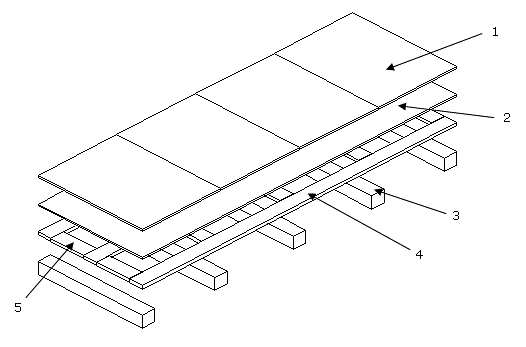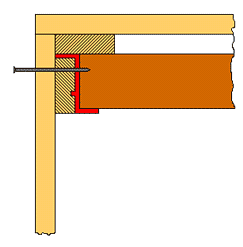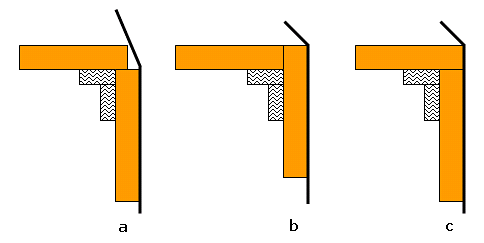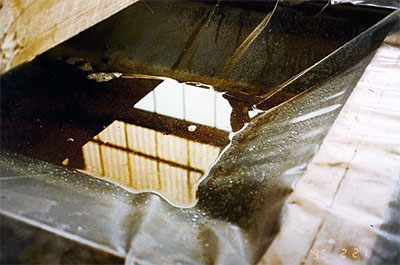The lid of the box/crate closes the top of the package and represents a flat surface that can be evenly loaded. Depending on the design of the box/crate, the lid rests on the battens of the side walls or on additional frames or vertical supports inside the packages if the height or width of the box/crate is larger or if higher loads are expected as a result of other cargo being stacked on top of the box/crate. The actual load-bearing capacity of the lid is achieved by the lid-support members beneath the cladding and battens in conjunction with the vertical supports. 
Figure 66: Lid construction (with sheet material cladding) Key (Figure 66):
For examples of how to support the lid-support members in order to conduct the stacking forces to the floor of the box, see Figures 59 and 60. When the lid-support members rest on vertical supports, the lid-support members are flush with the top horizontal longitudinal battens of the side walls. This must be taken into account when designing the walls. The safety clearance between the vertical supports / lid-support members and the packaged goods must be maintained. Lid-support members have two fundamental tasks:
When the boxes/crates are handled by crane, lateral compressive forces arise as a result of the positioning of the ropes. These must be absorbed by lid-support members located in the region of the slinging points. See section 1.4.6. Lid-support members are fitted in the box/crate before the lid is fitted and fixed to the side walls from the outside by nailing into the grain. The distance between the lid-support members should not exceed 80 cm and the distance to the end walls should not exceed 40 cm. It is also possible to fit and connect the lid-support members using different methods, for instance with brackets.  Figure 67: Lid-support member with bracket Figure 67: Lid-support member with bracket
These brackets are only available for squared lumber cross-sections of up to 120 x 100 mm. The area under pressure on the top horizontal side-wall batten is the same as if the lid-support member were to rest directly on the batten. The advantage of this method is that the box can be constructed at a lower height. In order to prevent the crane ropes from lifting the cladding of the lid, in particular in the case of solid lumber cladding, this cladding must be offset from the cladding of the side walls by approximately 0.5 cm on both sides. With boxes for heavy cargoes and crates, however, the slinging points must additionally be protected with protective plates. 
Figure 68: Examples for the arrangement of the lid boards – advantages and disadvantages The lid board is offset slightly (Figure 68a). The lid board abuts the side cladding (Figure 68b). The lid board rests flush on the side board. The rope can lift the lid board during craning and loosen or remove the cladding (Figure 68c). The underside of the lid should always be fully lined and sealed with PE film (200 µm thick) and below this a rigid plastic twin-wall sheet or hardboard sheet. This arrangement of a twin-wall sheet or hardboard sheet with a film layer between the cladding of the lid and the lid battens is designed to protect the package from the ingress of water, for instance from rain. This relatively rigid intermediate layer also ensures that no water pockets are formed. 
Figure 69: Water pocket on the lid film. There is Water pockets such as those shown in Figure 69 can be avoided by the use of a closed lid construction. The weight of such a quantity of water can cause the intermediate film layer to burst, resulting in water pockets on the film cover. This in turn tightens the film cover over the corners and edges and threatens the efficacy of the corrosion protection. At low temperatures, ice can form which can cut the lid film or the film cover. |
| Top of pageContents |
